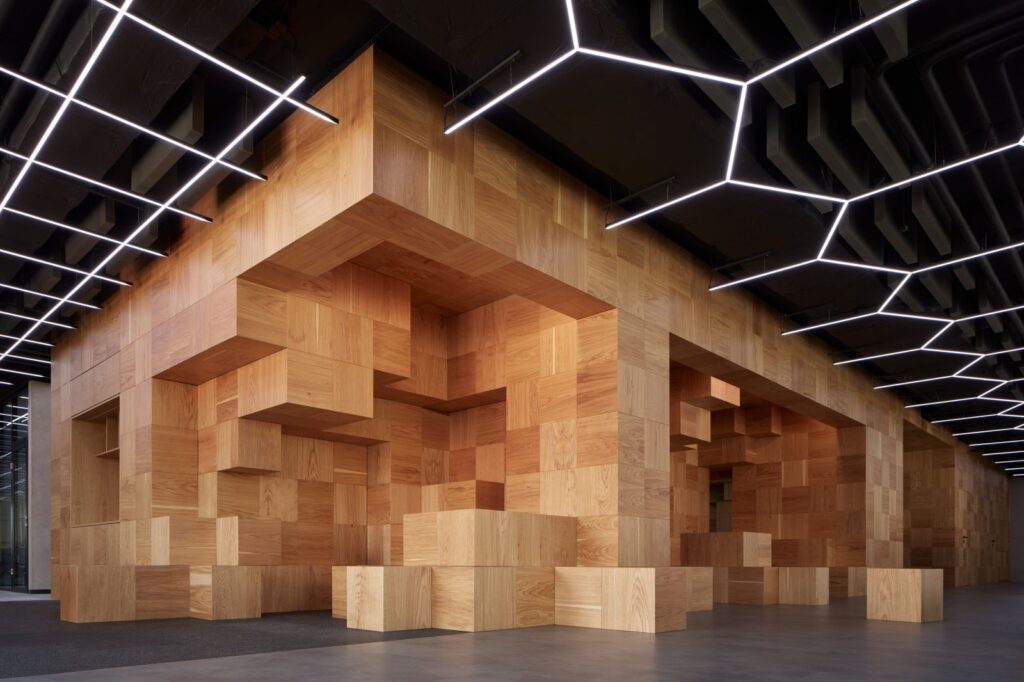Price f(x) Offices by collcoll

The changes in working habits brought about by digitalisation, which the pandemic has only hastened, are part of Price f(x)’s identity. The management and employees of Price f(x) use their offices primarily for meetings that stimulate creative dialogue. By their very nature, they are an open space for variable use, not subject to the stereotypes of work cubicles or traditional open space.
The main brief was to expand the core offices and provide an additional floor with maximum flexibility of use. Vertically connecting two floors tends to be problematic if the natural flow of the space is to be maintained. The two floors are tectonically connected by a structure composed of thousands of wooden pixels, which modulates the space around it and becomes its internal landmark.
At the core of the structure is a new interior staircase and, for the more adventurous, a slide. Hidden inside the wooden cells are personal lockers, dressing rooms and function rooms, while the individual fragments organically create nooks designed for informal seating and public presentations.
The regular structure is also written into the universal light grid above the entire space, which functions as a screen that is controlled down to the individual pixels (LEDs). This is also projected onto the bar counter/display, which also functions as a reception desk. The lighting interface is not only a dominant feature of the interior spaces. The luminous ceiling is also projected outwards into the Karlín space, and cannot be missed in the night landscape.
Spectrum of regulation
The inputs and outputs of the media (ventilation, air conditioning and heating capacity, sanitation capacity, …) of the individual spaces are the limit of the space capacity. But at one moment the whole company can meet in a café or a stacked conference room and plan visions for the future – or disperse and work in small teams on day-to-day business matters. Therefore, capacities are not distributed by space (classic open space with square meters per head). We distribute room capacities over time by controlling the environment.
A comprehensive control system measures and evaluates environmental data in real time. This allows it to know how many people are in which room, what the air quality and ventilation intensity are, and it can also dynamically adjust the lighting colour scheme. The system can control every single chip and the ceiling becomes a screen. It provides optimal lighting during working hours, but can also interact with people’s movements to create a corporate party atmosphere.
Spectrum of space
The entire floor can operate in conference room mode with café and dispersal areas. At the same time, the entire floor can be physically (sensually) divided. Transparent walls that can be made opaque, sliding panels that divide the space, as well as the controllable atmosphere of the rooms are used for this purpose.
The largest space is a café with a shared kitchen and an interactive bar. It serves as an informal setting with tables, couches, armchairs, bar stools and chairs. The conference room is equipped with a long table that can be divided into segments. The room itself can be separated by an acoustic sliding partition.
The intermediate spaces function as a dispersal area with no prescribed use, with scattered seating and amphitheatres. Corridors are eliminated and replaced with, for example, a pass-through lounge area with a punching bag, pool table and hayracks. The only specific (enclosed) rooms are the focus rooms with capacities ranging from two to sixteen people.
Spectrum of comfort
Furniture has been carefully selected or custom designed. The aim was to create a spectrum of comfort to suit different ways of working. From upholstered armchairs and swing chairs, to tilting plastic chairs in the conference room, office chairs for long sessions, heavy and solid chairs at the café, tables and square cubes within the wooden structure.
Wooden structure
The wooden structure occupies part of the floor plan away from the windows and hides the technical facilities. Externally, it offers semi-enclosed alcoves and amphitheatres extending informal spaces for work and presentations. The structure includes stairs to the upper floor and a tube slide.
The structure is aesthetically and technologically inspired by the creation in the game Minecraft. The visible surfaces of the structure in a 40 x 40 cm grid are veneered and the composition of the veneering is completely random, it was necessary to create a system that allows the random placement of individual cubes in a pre-designed final shape. Source by collcoll.
Location: Meteor Centre C, Thámova 681/32, 186 00 Prague, Czech Republic
Architect: collcoll
Design: Šimon Kos, Adam Kössler Libor Mládek, Mark Kelly
Project managment: Veronika Horáčkova, Kateřina Nováková
General contractor: Capexus [construction manager Tomáš Dvorský],
General engineer: Bauhanz
Metering and regulation, lighting solution: sysloop engineering, HVAC: AREA TZB
Electric engineering: COM project
Audio-video: AV24
Construction solutions: STASAPO
Joinery products / custom-made furniture: Olbert Tomáš
Slide: Alfeko
Locksmith construction: Tomáš Koudelka
Graphic design, illustrations: Klára Tesárová
Stickers: Michal Orlovský
Client: Price f(x)
Gross floor area: 850 m2
Usable floor area: 800 m2
Cost: 1,8 mil. €
Year: 2022
Photographs: BoysPlayNice, Courtesy of LINKA





